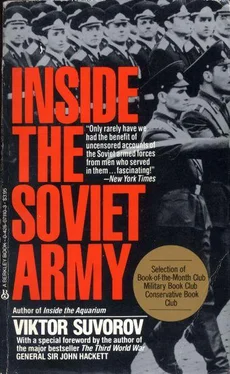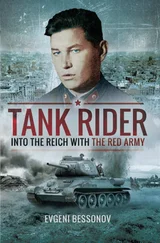There are exceptions. In some cases it is essential to use a particular calibre and no other. For example, the 122mm, 40-barrel multiple rocket launcher must be of precisely that calibre-no more and no less. Its rockets are therefore given a special designation; they are called `Grad' rockets. This is the only way in which they are ever referred to-they are never called `122mm' rockets. One makes this a habit from one's very first day. Then, if someone orders `1–2–2 he is referring to howitzer shells, but if he orders `Grad', he means rockets.
3
Western analysts find it hard to understand why the Soviet Union has turned away from its old, well-tried standard calibres. Soviet analysts, for their part, wonder why Western designers stick so stubbornly to old specifications. The British have an exceptionally powerful 120mm tank gun. An excellent weapon. They also have a useful 120mm recoilless gun. One of them was developed some time ago, the other more recently. Obviously, they use quite different shells. Why not use different calibres-one could be 120mm, the other 121mm? Or leave the calibres as they are; just change the designation of one to 121mm. Why not?
The same applies to West Germany and to France. Both countries have excellent 120mm mortars and both are working on the development of new 120mm tank guns. Of course this works well enough in peacetime. Everything is under control when the soldiers are professionals, who are quick to understand a command. But what happens if, tomorrow, middle-aged reservists and students from drama academies have to be mobilised to defend freedom? What then? Every time 120mm shells are needed, one will have to explain that you don't need the type which are used by recoilless guns or those which are fired by mortars, but shells for tank guns. But be careful-there are 120mm shells for rifled tank guns and different 120mm shells for smoothbore tank guns. The guns are different and their shells are different. What happens if a drama student makes a mistake?
The Soviet analysts sit and scratch their heads as they try to understand why it is that Western calibres never alter.
Secrets, Secrets, Secrets
1
The 41st Guards Tank Division was issued with T-64 tanks at the beginning of 1967. Of course, its soldiers knew nothing about this. They joined the division, served it honourably for two years and then went back to their homes; other soldiers came, learned something about tanks but went home having heard nothing about the T-64 and never having seen one. In 1972 the division was reequipped with the new T-72s and the T-64s were sent to Germany. The soldiers, of course, knew nothing about this-neither that the division had received new tanks nor that the old ones had gone. The soldiers serve in a division, they are trained by it for war but they know nothing about its tanks.
To the Western reader this may seem rather strange. However, when I came to the West and took my first look at Western armies, I was astounded to discover that Western soldiers knew the names of their tanks, and that they drive and fire from them. This seemed absurd to me, but I was unable to obtain any explanation of this strange policy.
In the Soviet Army everything is secret. When the war began it was not only the German generals who knew nothing about the T-34 tank-even the Soviet generals knew no more than they did. It was being mass-produced, but this was kept secret. Not even the tank forces knew of its existence. The new tanks were moved from the factories to some divisions, but only to those which were a long way back from the frontiers. They were ferried by a factory team (totalling 30 drivers for the whole of the Soviet Union) in convoys, the like of which had never been seen before, escorted by NKVD officers, who were forbidden even to talk to the drivers. They travelled only at night and the tanks were always completely covered with tarpaulins. The routes they took were closed to all other traffic and heavily guarded. When the tanks reached their destination, they were off-loaded by the factory team, who then drove them into vehicle parks, surrounded by high walls, inside which they were put into storage.
The tank crews were quickly instructed on various features of the new tanks, but they were not told what the new tanks were called or shown them. The gunners were, however, introduced to the new gunsights and taught how to use them, firing from old tanks. The drivers were given intensive training in the old tanks after being told that there was a new tank in the offing, which had to be driven rather differently. The drivers did not, of course, know whether the division already had this new tank or not. The tank commanders, too, were told a certain amount and shown how to service the engine, but they were not told the name of the tank from which the unusual engine came or given its horse-power. In short, the division was simply retrained, but only used the old tanks.
Then came the war, unexpected and terrifying. The first echelon divisions, which had good, although not secret equipment, were torn to pieces in the first battles. While this was happening, the divisions in the rear areas received orders to go into the tank parks, to take the tanks out of storage and to familiarise themselves with them. It took them two weeks to do this and after a further two weeks they reached the front. Then in these completely unknown tanks, the divisions took on Guderian's armoured columns. It was soon clear that they could operate them very well. After all, a driver who can handle a Volkswagen like a champion would not take long to master a Mercedes. That is how it was done in the Soviet Army then and how it will be done in future-they learn on a Volkswagen, but keep the Mercedes secretly hidden away until it is really needed.
But, of course, the T-34 was not the only surprise awaiting the Germans. They discovered the existence of the `KV' heavy tank only when they met it in action; before that they had not even heard of it. Nor, for that matter, had its Soviet tank-crews had any idea of its existence-the KV had been secretly stored away. The German troops soon met the `Stalin Organ' for the first time, too, and panicked when they did so. In peacetime sub-units armed with these excellent weapons had masqueraded as pontoon-bridge battalions, whose uniforms they had worn, with the result that most of their own soldiers had not realised that they were in reality rocket troops. Their retraining started only when the war began, but even then only the battery commanders knew the correct designation of their rocket launchers. The remaining officers, NCOs and other ranks did not even know what the equipment which they were using in battle was called. The launchers were marked with the letter K (standing for the Komintern factory in Voronezh). Naturally, no one, even the battery commanders, knew what this stood for and the result was that the soldiers on every front almost simultaneously christened these splendid weapons `Katerina', `Katya' or `Katyusha'. It was under this last name that they went down in history. Their correct designation-BM-13-was only allowed to be used in secret documents from the middle of 1942 onwards and it was not used in unclassified papers until after the end of the war.
2
The policy of observing the strictest rules of secrecy has completely justified itself. For this reason it is universally accepted and is applied with ever greater rigour. As a result, officers serving in a nuclear submarine may know, for instance, the output of the boat's reactor, if they are involved in its maintenance, but they will not know the maximum depth to which the boat can dive, since this does not concern them. Others may know this maximum depth, but will not know the range of the missiles which the submarine carries.
Читать дальше












